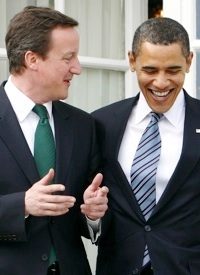
Queen Elizabeth appointed British Conservative Party electoral victor David Cameron as Prime Minister on May 11, shortly after his predecessor, Gordon Brown of the Labor Party, resigned. Brown’s resignation came after talks on forming a Labor coalition with Nick Clegg’s Liberal Democrats broke down.
Voice of America quoted Cameron’s statement that the new coalition government with the Liberal Democrats represents a "historic and seismic shift" in Britain’s political landscape. Speaking on May 12 with Clegg at his side, Cameron said that key provisions of the new government will include "freedom, fairness and responsibility." He described the coalition as "a government that will last," and said a united Britain can look forward to better days.
Since none of Britain’s three major parties achieved a majority in Britain’s May 6 election, the country found itself with its first “hung Parliament” since 1974. Under the British system, if no party achieves a majority of seats in Parliament, a government must be formed from a coalition of cooperative parties. Cameron’s Conservative Party won the largest number of votes and 305 seats, but fell short of the 326 seats needed to have a majority in Parliament. Brown’s Labour Party won 258 seats, and Clegg’s Liberal Democrat Party came in third with 57 seats.
Shortly after midnight on May 12, Liberal Democrats leaving a meeting of their Parliamentary party’s Federal Executive announced that a coalition deal with the Conservatives had been "approved overwhelmingly.” Cameron, therefore, will lead a coalition government of the Conservatives and Liberal Democrats as prime minister and Clegg will be deputy prime minister, meaning he will take the prime minister’s questions in Cameron’s adsence.
The British Daily Mail of May 12 reported that Cameron will lead a government with five Liberal Democrats in the cabinet, which consists of the Prime Minister and some 22 cabinet ministers. The most politically influential of these will be popular Liberal Democrat treasury spokesman Vince Cable, who is expected to assume the post of Chief Secretary to the Treasury.
There are some distinct differences between the U.S. cabinet — which is part of the executive branch of government — and the UK cabinet, which in recent years has been made up almost entirely by members of the House of Commons.
The Daily Mail reported: “There is a clear advantage for the Tories [Conservatives] in involving Mr. Cable in pushing through the unpopular spending cuts that will be necessary to deal with the soaring deficit.”
The article also reflected that the issue of amnesty for illegal immigrants — a hot-button political issue in the United States — is also a factor in British politics, observing: “The Tories have forced the Lib Dems to ditch their plans for an immigration amnesty. But the third party also favours a softer approach to criminal justice, with their manifesto calling for most sentences under six months to be replaced by community orders.”
A report in the New York Times for May 12 observed:
The Conservatives and Liberal Democrats are far apart on many issues, from immigration to relations with Europe, and full details on what each conceded will not be public until Wednesday [May 12]. But aides to Mr. Clegg said the Liberal Democrats would have five ministers in the new government, including Vince Cable, a former oil economist who has called for sharp spending cuts. The Liberal Democrats’ prized issue of electoral reform would be put to a voter referendum, though in its least far-reaching form.
A blog from the Adam Smith Institute published by the Christian Science Monitor on May 11 summarized potential areas of agreement between the Conservatives and Liberal Democrats:
The Conservatives are unlikely to modify their support for Trident [the United Kingdom’s Trident-based nuclear weapon program], or the Liberal-Democrats their endorsement of voting reform.
There are two policies, however, both advocated by the Adam Smith Institute, on which agreement might be reached almost immediately. The first is for a lifting of the starting threshold for income tax to £12,000. The thinking behind it is that those earning the minimum wage or less than half the average wage should not be charged income tax at all – they have enough problems making ends meet as it is.
This runs totally counter to Gordon Brown’s view that he should decide how much tax everyone pays, combining high taxes on low earners with tax credits to reimburse then. It is a system that makes everyone a state dependent, with welfare even going to those earning 50 percent more than the average income.
There are many parallels between British and American political parties, including the fact that on both sides of the Atlantic the party names and reputations for fiscal conservatism or liberalism must often be viewed with healthy skepticism.
In general, the British Conservative Party has much in common with the U.S. Republican Party, a viewpoint that was reinforced by the favorable rapport that existed between Conservative Prime Minister Margaret Thatcher and her contemporary as U.S. President, Ronal Reagan. An article in Wikipedia notes: “As prime minister, Thatcher focused on establishing a political ideology that became known as the “New Right” or Thatcherism, based on social and economic ideas from the United States.”
The same article also notes the David Cameron, following his accession to the prime minister position, “announced his intention to reform and realign the Conservatives, saying they needed to change the way they looked, felt, thought and behaved, advocating a more centre-right stance as opposed to their recent staunchly right-wing platform.”
The above description of remaking the Conservative Party would aptly describe the Republican Party’s progressive evolution from conservatism to neoconservatism between the administrations of Calvin Coolidge and Dwight Eisenhower. Instead of opposing Franklin Roosevelt’s big-spending, socialistic New Deal policies, the Republicans came to emulate them.
In contrast, Wikipedia’s citation of the Labour Party’s own description of itself as a “democratic socialist party” makes it sound like a party in which Barack Obama would feel very much at home, were he British. The Labour Party Manifesto 2010, posted on the party’s website, states:
To deliver a future fair for all we need to:
• Rebuild our economy
• Reform and protect our public services
• Renew our politics
Of more interest, however, since it will now share in a coalition government with the Conservatives, is the Liberal Democrat Party, defined by Wikipedia as “a centrist to centre-left social liberal political party.”
The article continues: “Promoting social liberalism, the Liberal Democrats voice strong support for constitutional reform, electoral reform, civil liberties and rights, and higher taxes for public services.”
Presuming that these descriptions are reasonably accurate, what might we expect from Britain’s new coalition government headed by a Conservative advocating “a more centre-right stance” (sounds a lot like Mitt Romney or Newt Gingrich!) working in partnership with a “a centrist to centre-left social liberal political party”?
Imagine a government headed by any neo-con Republican, but with Joe Biden as vice president and Nancy Pelosi serving in the cabinet!
Photo: UK’s new Prime Minister David Cameron met with President Barack Obama at Winfield House in London, April 1, 2009: AP Images



